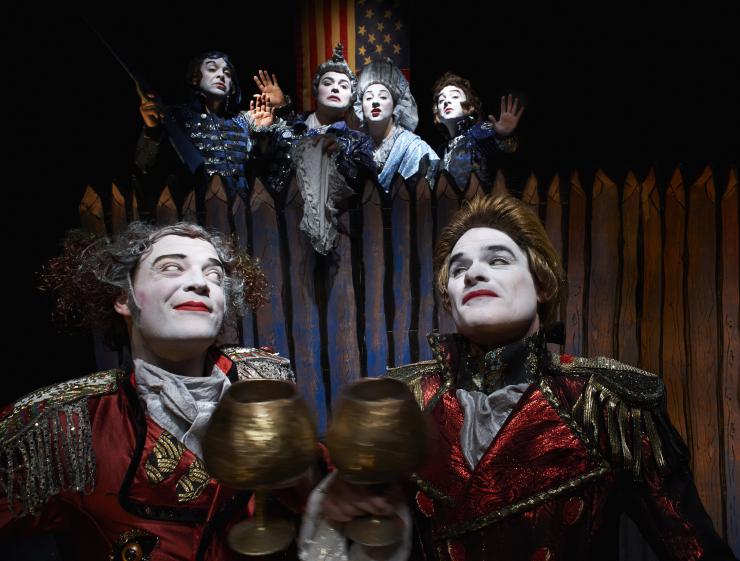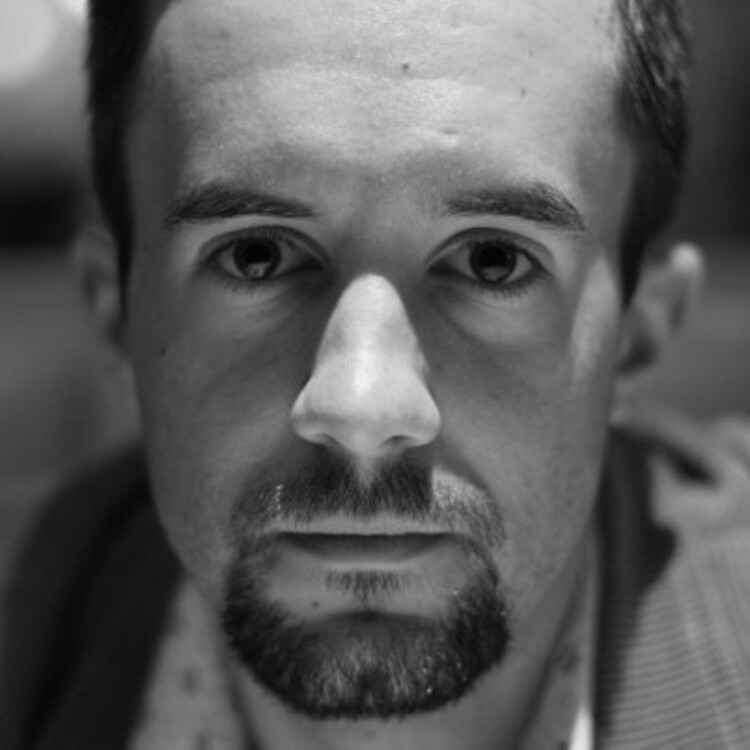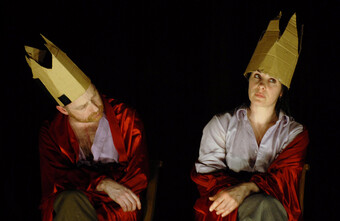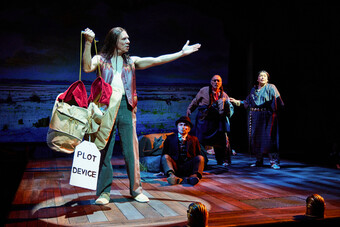The Quotidian as Epic
VideoCabaret’s War of 1812
In the Canadian national mythology, the story of the War of 1812 is, as noted Canadian historian and author Pierre Berton once wrote, the story of “the war that Canada won, or to put it more precisely, did not lose,” and any attempt to understand the subtle but important differences between the United States and Canada, two countries with much in common, must deal with the Canadian conceptions of the War of 1812.
1812 gave us the famous story of Laura Secord, running through the night to warn James FitzGibbon of the impending American attack at Beaver Dams on the Niagara Peninsula. It gave us the tale of the redcoats burning the White House and the famous portrait of George Washington saved by Dolley Madison. 1812 also left a bloody legacy: the Battle of Lundy’s Lane remains among the bloodiest conflicts ever on Canadian soil. Native populations were betrayed, displaced, and destroyed. The senseless fighting of that very unpopular war has shaped, and perhaps continues to shape, the two countries’ mutual perceptions of each other. VideoCabaret’s The War of 1812 (at the Young Centre for the Performing Arts until the end of May 2013) is one attempt to understand the war and some of its consequences, and the production does so in a complex and engaging way.
VideoCabaret creates unique and visually stunning theatre that simultaneously celebrates Canada’s history even as it brings the heroes and villains of that story down to size.
Subtitled The History of the Village of Small Huts, 1812–15, this play is one part of a twenty-play-cycle conceived and written by Michael Hollingsworth. Originally presented from 1985–1999, the plays have been reconceived for repertory since 2000, covering Canada’s history from the first European settlement in Quebec to the era of President Bush 41 and Prime Minister Brian Mulroney. The History of the Village of Small Huts— small huts being a translation of the Iroquoian word kanata, which explorer Jacques Cartier used to refer to the area under Chief Donnacona, and where Samuel de Champlain later established l’Habitation, the origins of Quebec City—represents Hollingsworth’s attempt to understand and theatricalize Canada’s history, “an historical epic for an audience raised on Rock and TV” at a time when most Canadians “knew more about the Alamo than the Algonquin.” Combining elements of satire and tragedy with a highly stylized theatrical aesthetic, VideoCabaret creates unique and visually stunning theatre that simultaneously celebrates Canada’s history even as it brings the heroes and villains of that story down to size.
The company’s name captures some of its theatrical vocabulary. The set is minimalist and most of the work is done with the superb lighting design of Andy Moro. The stage is framed off to look almost like a television set such that when the actors are downstage only their torsos are visible, while upstage we can see them head to toe in the exquisite costumes by Astrid Janson, which visually leap off the stage in bursts of color and vary between the absurdly comical and the depressingly realistic. The wigs from Alice Norton are so elaborate that they seem to have lives of their own, and taken all together it is a stunning combination of visual effects.
Eight actors in white makeup with hyperreal red lips and eyebrows that Joan Rivers must envy—Paul Braunstein, Aurora Browne, Richard Alan Campbell, Richard Clarkin, Mac Fyfe, Derek Garza, Jacob James, and Linda Prystawska—portray a cast of some thirty-two characters plus generic “soldiers” and a cow in a play of dizzying speed and pace. At times characters change costumes and enter as new characters in as little as thirty seconds, with movements so precise that it seems, at times, that we are watching an elaborate social dance. In a way, we are, of course, and this is part of the pleasure of VideoCabaret’s work and this show in particular. There is never any attempt to hide the artifice with the result that the show itself seems effortless with a level of complexity that really only fully registers on the way back home. The seamless execution makes The War of 1812 an experience I like to call (borrowing from art critic Dave Hickey) a “Huh… wow!” moment. It’s the kind of thing that washes over you and then hits you later, further enhancing the delight of the show.

The visual world both enhances and prepares us for the characters Hollingsworth creates. In this world the small details of history, as well as rumor and conjecture, become central characteristics. It’s like history on a slight angle, and with much better makeup. Jacob James’s James Madison, for example, comes across as a diminutive and unpopular president who seeks war to rally a young nation around the flag while regularly sipping on booze laced with opium. (While it is true that Madison’s popularity as president suffered and he faced a fractious cabinet and Congress, his use of opium—especially with such frequency—is a matter of conjecture.) Aurora Browne’s portrayal of The Prophet, the Shawnee political and religious leader who helped to lead the Tecumseh Confederacy against the Americans in the war, is at turns hilarious and menacing, ranging between a rabid anti-settler stance and a comedic propagandist for Tecumseh. Paul Braunstein’s Canadian Governor General George Prevost is a hilariously inept fop, and Mac Fyfe’s FitzGibbon as a menacing brute is a far cry from the typical portrayal of him as a noble hero who saved Canada from certain occupation.
This stylized theatrical presentation highlights not only the absurdity of this war, but also the absurdity of all wars, and the bastardizations of both history and 'facts' used to justify them.
This stylized theatrical presentation highlights not only the absurdity of this war, but also the absurdity of all wars, and the bastardizations of both history and “facts” used to justify them. As much of Canada is enthralled with commemorating the War of 1812 during its bicentennial (indeed, as I write this, a well publicized reenactment is taking place at old Fort York in Toronto to commemorate the Battle of York—which the Canadians decidedly lost), The War of 1812 reminds us that the war that Thomas Jefferson suggested would be a “mere matter of marching” was bloody and brutal, a comedy of errors and pride and a tragedy of human suffering. It also serves, in our own era of war and “mission[s] accomplished,” that, as Hollingsworth says, “what is going to happen has already happened.” One just needs to know where to look.
The serious levity of the entire event contrasts to the somber and serious reenactments, where the pieties of patriotism and militarism are almost always highlighted in ways designed to appeal to our guts rather than our heads. And this, it seems to me, is the crux of the project. If we cannot rely on theater to challenge pieties, where then can we laugh at the absurdity of our own histories? If The War of 1812 bends history for dramatic effect, it does so in an effort to remind us that the seminal events—the things we’re taught in school to speak of in hushed tones, and the things that historical reenactments present with little or no hint of irony—are almost always a potent mixture of the quotidian with the epic. VideoCabaret’s The War of 1812 treats the quotidian as epic, and leaves us feeling that history is as much a source of comedy as it is tragedy. In short, the play invites us to think of this war and the history surrounding it as a series of “huh… wow” moments. Not everything is laden with significance, but even those things that are, are not, and should not be, above a good laugh. After all, as this play reminds us in its closing scenes, the borders in 1815 were just the same as they were in 1811, and two nations, similar but very different, continue to exist in a close but sometimes uneasy relationship to one another. To paraphrase Hollingsworth’s note in the program, blink your eyes and you’re here, blink your eyes and you’re there; the States and Canada; comedy, tragedy; the epic and the mundane. Huh. Wow.










Comments
The article is just the start of the conversation—we want to know what you think about this subject, too! HowlRound is a space for knowledge-sharing, and we welcome spirited, thoughtful, and on-topic dialogue. Find our full comments policy here